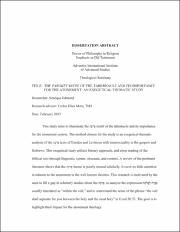The PAROKET motif of the tabernacle and its importance for the atonement : an exegetical-thematic study
Abstract
This study aims to illuminate the פָּרכֶֹת motif of the tabernacle and its importance
for the atonement system. The method chosen for the study is an exegetical-thematic
analysis of the פָּרכֶֹת texts of Exodus and Leviticus with intertextuality in the gospels and
Hebrews. This exegetical study utilizes literary approach, and close reading of the
biblical text through linguistic, syntax, structure, and context. A review of the pertinent
literature shows that the פָּרכֶֹת theme is poorly treated scholarly. It receives little attention
in relation to the atonement in the well known theories. This research is motivated by the
need to fill a gap in scholarly studies about the פָּרכֶֹת , to analyze the expression מִבֵּ֣ית לַפָּר֔כֶֹת
usually translated as “within the veil,” and to understand the sense of the phrase “the veil
shall separate for you between the holy and the most holy” in Exod 26:33. The goal is to
highlight their impact for the atonement theology.
The findings from the study illustrates how important the tabernacle for Exodus
and how essential is the פָּרכֶֹת in the tabernacle is, either for the structure or for the
function. The פָּרכֶֹת defines and differentiates the tabernacle. The פָּרכֶֹת is solidly attached
to the process of collective atonement. The linguistic considerations of the study show
that מִבֵּ֣ית לַפָּר֔כֶֹת should be understood as referring to the entire tabernacle instead of one
apartment or another. The study suggests that the semantic of the verb בָּדַל marks a degree
of holiness and refers to a way inside the tabernacle but should not be seen as a barrier.
The study demonstrates that the understanding of the פָּרכֶֹת motif significantly
affects the theology of atonement. The פָּרכֶֹת is essential to understand the process of
atonement for it recalls the place, the time, the event, and the minister in the atonement
system. The findings of the study prompts a rethinking of the typology of the tabernacle,
the meaning of atonement paying attention to the פָּרכֶֹת role, the search of meaning of the
collective ritual of atonement, and the possible interpretation of passages on the
purification of the sanctuary taking in hand the פָּרכֶֹת motif.


